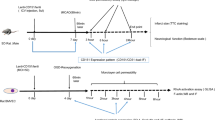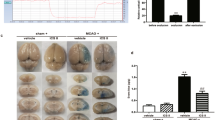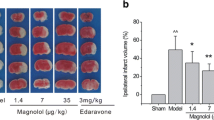Abstract
Focal cerebral ischemia results in an increased expression of matrix metalloproteinase-9 (MMP-9), which induces vasogenic brain edema via disrupting the blood–brain barrier (BBB) integrity. Recent studies from our laboratory showed that baicalin reduces ischemic brain damage by inhibiting inflammatory reaction and neuronal apoptosis in a rat model of focal cerebral ischemia. In the present study, we first explored the effect of baicalin on the neuronal damage, brain edema and BBB permeability, then further investigated its potential mechanisms. Sprague–Dawley rats underwent permanent middle cerebral artery occlusion (MCAO). Baicalin was administrated by intraperitoneally injected twice at 2 and 12 h after the onset of MCAO. Neuronal damage, brain edema and BBB permeability were measured 24 h following MCAO. Expression of MMP-9 protein and mRNA were determined by western blot and RT–PCR, respectively. Expression of tight junction protein (TJP) occludin was detected by western blot. Neuronal damage, brain edema and BBB permeability were significantly reduced by baicalin administration following focal cerebral ischemia. Elevated expression of MMP-9 protein and mRNA were significantly down-regulated by baicalin administration. In addition, MCAO caused the decreased expression of occludin, which was significantly up-regulated by baicalin administration. Our study suggested that baicalin reduces MCAO-induced neuronal damage, brain edema and BBB permeability, which might be associated with the inhibition of MMP-9 expression and MMP-9-mediated occludin degradation.






Similar content being viewed by others
References
Hawkins BT, Davis TP (2005) The blood-brain barrier/neurovascular unit in health and disease. Pharmacol Rev 57(2):173–185
Correale J, Villa A (2009) Cellular elements of the blood-brain barrier. Neurochem Res 34(12):2067–2077
Tavelin S, Hashimoto K, Malkinson J, Lazorova L, Toth I, Artursson P (2003) A new principle for tight junction modulation based on occludin peptides. Mol Pharmacol 64(6):1530–1540
Lochhead JJ, McCaffrey G, Quigley CE et al (2010) Oxidative stress increases blood-brain barrier permeability and induces alterations in occludin during hypoxia-reoxygenation. J Cereb Blood Flow Metab 30(9):1625–1636
Chi OZ, Hunter C, Liu X, Weiss HR (2009) Effects of exogenous excitatory amino acid neurotransmitters on blood-brain barrier disruption in focal cerebral ischemia. Neurochem Res 34(7):1249–1254
Gidday JM, Gasche YG, Copin JC et al (2005) Leukocyte-derived matrix metalloproteinase-9 mediates blood-brain barrier breakdown and is proinflammatory after transient focal cerebral ischemia. Am J Physiol Heart Circ Physiol 289(2):H558–H568
Piao MS, Lee JK, Park CS, Ryu HS, Kim SH, Kim HS (2009) Early activation of matrix metalloproteinase-9 is associated with blood-brain barrier disruption after photothrombotic cerebral ischemia in rats. Acta Neurochir (Wien) 151(12):1649–1653
Dong H, Fan YH, Zhang W, Wang Q, Yang QZ, Xiong LZ (2009) Repeated electroacupuncture preconditioning attenuates matrix metalloproteinase-9 expression and activity after focal cerebral ischemia in rats. Neurol Res 31(8):853–858
Liu W, Hendren J, Qin XJ, Shen J, Liu KJ (2009) Normobaric hyperoxia attenuates early blood-brain barrier disruption by inhibiting MMP-9-mediated occludin degradation in focal cerebral ischemia. J Neurochem 108(3):811–820
Adibhatla RM, Hatcher JF (2008) Tissue plasminogen activator (tPA) and matrix metalloproteinases in the pathogenesis of stroke: therapeutic strategies. CNS Neurol Disord Drug Targets 7(3):243–253
Tu XK, Yang WZ, Shi SS, Wang CH, Chen CM (2009) Neuroprotective effect of baicalin in a rat model of permanent focal cerebral ischemia. Neurochem Res 34(9):1626–1634
Tu XK, Yang WZ, Shi SS et al (2010) Baicalin inhibits TLR2/4 signaling pathway in rat brain following permanent cerebral ischemia. Inflammation [Epub ahead of print]. doi:10.1007/s10753-010-9254-8
Tu XK, Yang WZ, Shi SS et al (2010) Spatio-temporal distribution of inflammatory reaction and expression of TLR2/4 signaling pathway in rat brain following permanent focal cerebral ischemia. Neurochem Res 35(8):1147–1155
Jemal A, Ward E, Hao Y, Thun M (2005) Trends in the leading causes of death in the United States, 1970–2002. JAMA 294(10):1255–1259
Huang J, Upadhyay UM, Tamargo RJ (2006) Inflammation in stroke and focal cerebral ischemia. Surg Neurol 66(3):232–245
Durukan A, Tatlisumak T (2007) Acute ischemic stroke: overview of major experimental rodent models, pathophysiology, and therapy of focal cerebral ischemia. Pharmacol Biochem Behav 87(1):179–197
Mehta SL, Manhas N, Raghubir R (2007) Molecular targets in cerebral ischemia for developing novel therapeutics. Brain Res Rev 54(1):34–66
Li H, Hu J, Ma L et al (2010) Comprehensive study of baicalin down-regulating NOD2 receptor expression of neurons with oxygen-glucose deprivation in vitro and cerebral ischemia-reperfusion in vivo. Eur J Pharmacol 649(1–3):92–99
Xue X, Qu XJ, Yang Y et al (2010) Baicalin attenuates focal cerebral ischemic reperfusion injury through inhibition of nuclear factor kappaB p65 activation. Biochem Biophys Res Commun 403(3–4):398–404
Yin F, Liu J, Ji X, Wang Y, Zidichouski J, Zhang J (2011) Baicalin prevents the production of hydrogen peroxide and oxidative stress induced by Abeta aggregation in SH-SY5Y cells. Neurosci Lett 492(2):76–79
Meng F, Liu R, Gao M et al (2011) Pinocembrin attenuates blood-brain barrier injury induced by global cerebral ischemia-reperfusion in rats. Brain Res 1391:93–101
Mao X, Yin W, Liu M et al (2011) Osthole, a natural coumarin, improves neurobehavioral functions and reduces infarct volume and matrix metalloproteinase-9 activity after transient focal cerebral ischemia in rats. Brain Res 1385:275–280
Wang Z, Leng Y, Tsai LK, Leeds P, Chuang DM (2011) Valproic acid attenuates blood-brain barrier disruption in a rat model of transient focal cerebral ischemia: the roles of HDAC and MMP-9 inhibition. J Cereb Blood Flow Metab 31(1):52–57
Lischper M, Beuck S, Thanabalasundaram G, Pieper C, Galla HJ (2010) Metalloproteinase mediated occludin cleavage in the cerebral microcapillary endothelium under pathological conditions. Brain Res 1326:114–127
Acknowledgments
The Key Laboratory (Neurosurgical Department) Funding from the Affiliated Union Hospital of Fujian Medical University, supported this work.
Author information
Authors and Affiliations
Corresponding authors
Rights and permissions
About this article
Cite this article
Tu, Xk., Yang, Wz., Liang, Rs. et al. Effect of Baicalin on Matrix Metalloproteinase-9 Expression and Blood–Brain Barrier Permeability Following Focal Cerebral Ischemia in Rats. Neurochem Res 36, 2022–2028 (2011). https://doi.org/10.1007/s11064-011-0526-y
Received:
Accepted:
Published:
Issue Date:
DOI: https://doi.org/10.1007/s11064-011-0526-y




